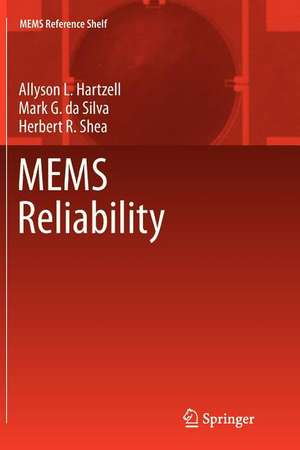MEMS Reliability: MEMS Reference Shelf
Autor Allyson L. Hartzell, Mark G. da Silva, Herbert R. Sheaen Limba Engleză Paperback – 27 dec 2012
MEMs Reliability, focuses on the reliability and manufacturability of MEMS at a fundamental level by addressing process development and characterization, material property characterization, failure mechanisms and physics of failure (POF), design strategies for improving yield, design for reliability (DFR), packaging and testing.
| Toate formatele și edițiile | Preț | Express |
|---|---|---|
| Paperback (1) | 727.31 lei 6-8 săpt. | |
| Springer Us – 27 dec 2012 | 727.31 lei 6-8 săpt. | |
| Hardback (1) | 1005.61 lei 6-8 săpt. | |
| Springer Us – 11 noi 2010 | 1005.61 lei 6-8 săpt. |
Preț: 727.31 lei
Preț vechi: 886.97 lei
-18% Nou
Puncte Express: 1091
Preț estimativ în valută:
139.18€ • 148.82$ • 116.04£
139.18€ • 148.82$ • 116.04£
Carte tipărită la comandă
Livrare economică 17 aprilie-01 mai
Preluare comenzi: 021 569.72.76
Specificații
ISBN-13: 9781461427360
ISBN-10: 1461427363
Pagini: 308
Ilustrații: XIII, 291 p.
Dimensiuni: 155 x 235 x 16 mm
Greutate: 0.44 kg
Ediția:2011
Editura: Springer Us
Colecția Springer
Seria MEMS Reference Shelf
Locul publicării:New York, NY, United States
ISBN-10: 1461427363
Pagini: 308
Ilustrații: XIII, 291 p.
Dimensiuni: 155 x 235 x 16 mm
Greutate: 0.44 kg
Ediția:2011
Editura: Springer Us
Colecția Springer
Seria MEMS Reference Shelf
Locul publicării:New York, NY, United States
Public țintă
ResearchCuprins
Introduction.- Reliability /Weibull, bathtub curve, basics (What is reliability?).- Failure Modes and Physics of Failure (POF).- Strategies for identifying root cause (FMEA).- Manufacturing Processes & Procedures.- Testing & Qualification Processes & Procedures.- Improving Reliability: Techniques and Tools.- Design for Reliability (DFR).
Textul de pe ultima copertă
Successfully bringing MEMS-based products to market hinges on engineering the component to have sufficient reliability for the intended application, yet the reliability and qualification methodology for MEMS based products is not widely understood. Companies that have a deep understanding of MEMS reliability because of specific high volume manufacturing experience generally view the details of a reliability program as a competitive advantage and are reluctant to share it. MEMS Reliability focuses on the reliability and manufacturability of MEMS at a fundamental product engineering level by addressing process development and characterization, material property characterization, failure mechanisms and physics of failure (PoF), accelerated testing and lifetime prediction, design strategies for improving yield, design for reliability (DfR), packaging and testing. Drawing upon years of practical experience and using numerous examples and illustrative applications, Allyson Hartzell, Mark da Silva, and Herbert Shea cover:
• How to design & manufacture MEMS components for reliability by focusing on basic tools such as reliability statistics, CAD methodologies, FMEA, tools & instruments for failure analysis, and product development methodologies.
• The different types of failure modes for silicon and metal-based MEMS, including failures originating in the design and manufacturing phases, and in-use failures (electrical, mechanical, and environmental) and how to avoid them.
• The testing and qualification procedures for MEMS reliability and the specific test protocols for accelerating specific MEMS- failures, leading to enhanced reliability understanding and accurate lifetime prediction.
MEMS Reliability will be of interest to engineers,researchers, and product managers involved in the production and development, of MEMS who want to learn more about determining and improving product reliability and implementing suchpractices within their own organizations.
"The MEMS Reference Shelf is a series devoted to Micro-Electro-Mechanical Systems (MEMS), which combine mechanical, electrical, optical, or fluidic elements on a common microfabricated substrate to create sensors, actuators, and microsystems. This series, authored by leading MEMS practitioners, strives to provide a framework where basic principles, known methodologies, and new applications are integrated in a coherent and consistent manner."
STEPHEN D. SENTURIA Massachusetts Institute of Technology, Professor of Electrical Engineering, Emeritus
• How to design & manufacture MEMS components for reliability by focusing on basic tools such as reliability statistics, CAD methodologies, FMEA, tools & instruments for failure analysis, and product development methodologies.
• The different types of failure modes for silicon and metal-based MEMS, including failures originating in the design and manufacturing phases, and in-use failures (electrical, mechanical, and environmental) and how to avoid them.
• The testing and qualification procedures for MEMS reliability and the specific test protocols for accelerating specific MEMS- failures, leading to enhanced reliability understanding and accurate lifetime prediction.
MEMS Reliability will be of interest to engineers,researchers, and product managers involved in the production and development, of MEMS who want to learn more about determining and improving product reliability and implementing suchpractices within their own organizations.
"The MEMS Reference Shelf is a series devoted to Micro-Electro-Mechanical Systems (MEMS), which combine mechanical, electrical, optical, or fluidic elements on a common microfabricated substrate to create sensors, actuators, and microsystems. This series, authored by leading MEMS practitioners, strives to provide a framework where basic principles, known methodologies, and new applications are integrated in a coherent and consistent manner."
STEPHEN D. SENTURIA Massachusetts Institute of Technology, Professor of Electrical Engineering, Emeritus
Caracteristici
Demonstrates how to design MEMs for reliability during the product life cycle focusing CAD methodologies and system level architecture Provides detailed information on the different types of failure modes, including but not limited to, design failures, manufacturing failures, and material failure, and how to avoid them Discusses testing, qualification, processes and procedures for MEMs reliability and the specific tests for enhancing reliability Includes supplementary material: sn.pub/extras



















